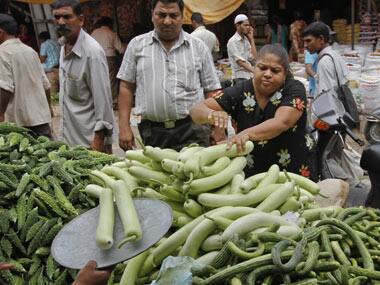Once again, India’s inflation numbers continue to confuse rather than clarify. Two days ago, retail inflation, as measured by the Consumer Prices Index (CPI), punched in at 5.4 percent, the second consecutive rise in as many months. And newspapers duly announced that Reserve Bank Governor Raghuram Rajan will have a good reason not to cut interest rates next month. But yesterday (14 July), the Wholesale Prices Index (WPI) went into deeper negative territory, clocking (-)2.4 percent – its eighth straight month of deflation. Since lower interest rates are more a business demand than that of anyone else, wholesale deflation worries ought to be giving Rajan as much sleepless nights as consumer inflation, which is still not in a frightening zone. [caption id=“attachment_2343866” align=“alignleft” width=“380”]  Reuters[/caption] When one index is pointing north and the other south, the chances are either one of them is wrong, or both. Or the two are trying to tell us different things. But, first, a few observations. #1: In June, the divergence between CPI and WPI reached its widest in years – 7.8 percent. In the whole of 2014, the divergence was less than 4 percent, but after that it has suddenly shot up to 7 percent-and-odd. There has to be an explanation for this divergence, and it cannot merely be due to the base year difference between CPI and WPI. #2: Overall inflation is not a threat for now. The CPI average for this calendar year up to June is 5.18 percent, and the 12-month average is 5.27 percent. The WPI average is (-)2.11 percent and zero for this calendar and the last 12 months. Thus, the CPI is stable, and the WPI is negative or stable when one averages out month-on-month variations. #3: Surprisingly, there is strong convergence in CPI and WPI food inflation rates, especially when we look at the 12-month averages. It’s 5.02 percent for WPI food inflation, and 5.84 percent for CPI food and beverages inflation. The difference is less than 1 percent considering that the two indices measure different items and weight them differently. While there is no doubt that the WPI needs to be refreshed because the current one has a base year that’s 11 years old (2004), the same is true for the Index of Industrial Production (IIP) too. Between 2004 and 2015, it is unlikely that the structure of Indian industrial output has remained the same. Also, the weak 2.6 percent average monthly IIP growth over the last 12 months (June 2014-May 2015) is fairly consistent with the zero percent wholesale inflation average for the July 2014-June 2015 12-month period. The small growth in industrial growth may be the result of weak consumer demand, which may have reduced industry’s pricing power, and the low wholesale inflation is the unsurprising result. Manufacturers are holding prices or cutting them to ensure growth – which is visible all around us in year-long discount sales on e-commerce sites and malls, and in weak corporate profits growth. The widening gap between CPI and WPI inflation may thus need more explanation than just the fact that CPI has a recent base and WPI an old one. The chances are that supply inefficiencies are worsening in India due to poor investment in infrastructure and rising transport and logistics costs – both for farm produce and industrial goods. Investing in new infrastructure and creating a single common market for farm and industrial goods and services by eliminating state-created barriers ought to be our first priority. The divergence between CPI and WPI cannot be an accident. The CPI is a cause for worry; the WPI is a cause for urgent reform and investment.
The divergence between CPI and WPI cannot be an accident. The CPI is a cause for worry; the WPI is a cause for urgent reform and investment.
Advertisement
End of Article
Written by R Jagannathan
R Jagannathan is the Editor-in-Chief of Firstpost. see more


)
)
)
)
)
)
)
)
)



